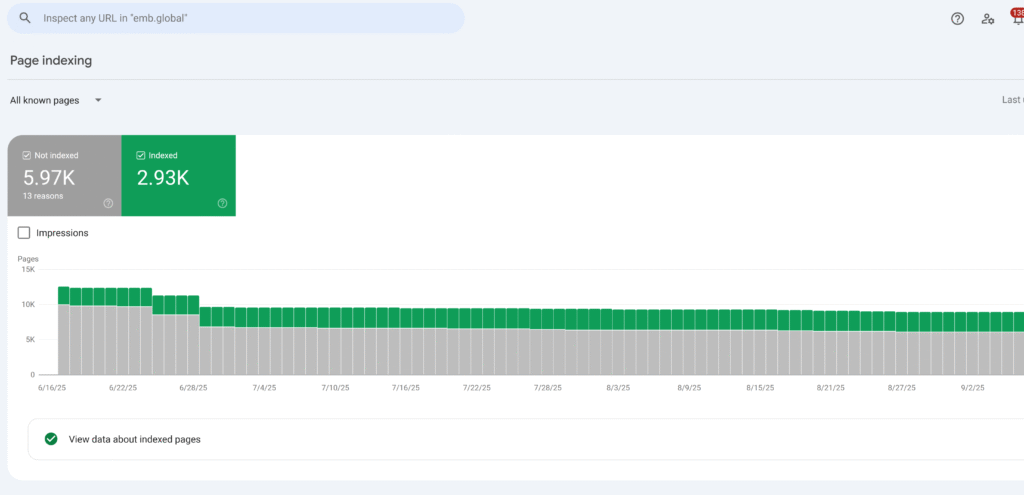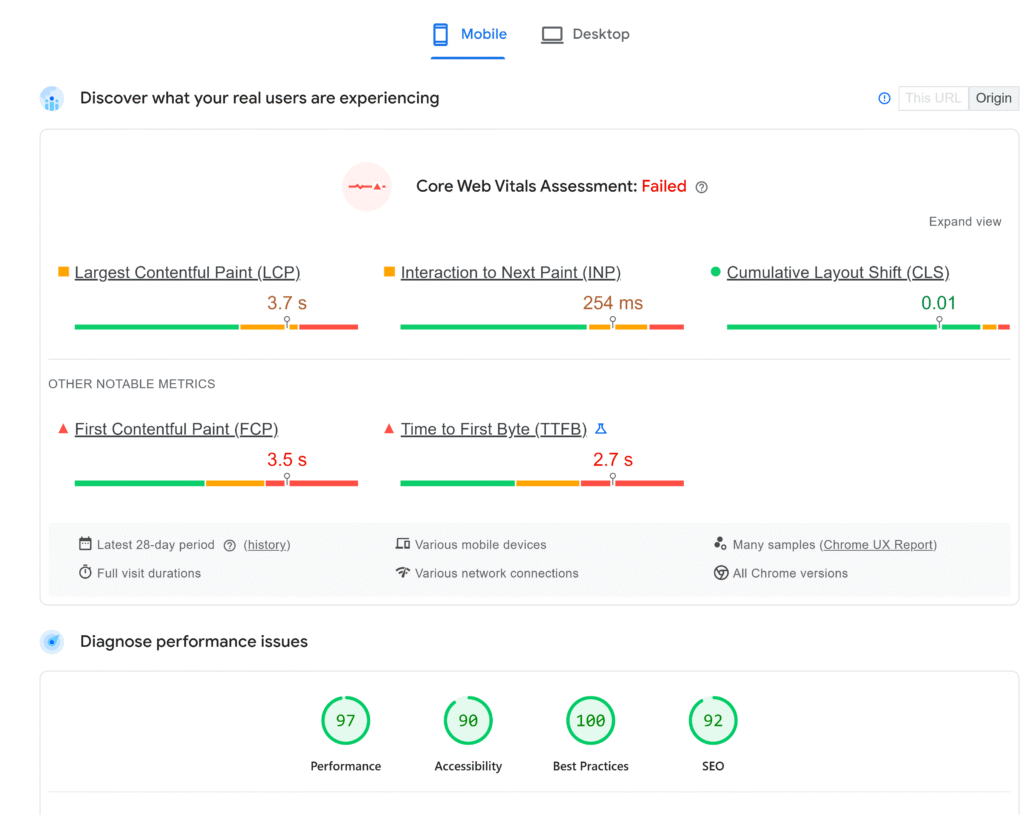Technical SEO might sound intimidating, but it’s actually the backbone of any successful search strategy. While content and backlinks get the spotlight, it’s the technical foundation that determines whether search engines can actually find, understand, and rank your content. And let’s face it – even the most amazing content won’t perform if Google can’t properly crawl your site!
This guide breaks down the essential technical SEO practices you need to implement right now. We’ll cover everything from basic site settings and speed optimization to mobile-friendly design and canonical tag implementation. By the end, you’ll have a clear roadmap to improve your site’s technical health and boost your search visibility.
Ready to get your hands dirty with some technical SEO magic? Let’s dive in!
Audit core technical SEO settings
Verify crawlability and index status in Google Search Console
First things first – you need to know if Google can actually see your site! Log into Google Search Console and check the Coverage report to see which pages are being indexed and which ones have issues.
Look for warnings or errors that indicate crawling problems. The Index Status report shows you how many pages Google has indexed over time – a sudden drop might signal a technical problem that needs fixing ASAP.
Use the URL Inspection tool to check specific URLs and see exactly how Google views them. This tool lets you:
- See if a page is indexed
- View how Google renders the page
- Check for mobile usability issues
- Request indexing for new or updated content

Fix crawl errors and submit an updated sitemap
Crawl errors are roadblocks that prevent search engines from properly discovering your content. Technical SEO forms the foundation for search engine visibility – without it, your content might never get discovered, no matter how great it is.
Common crawl errors include:
- 404 errors (pages not found)
- 500 server errors
- Redirect chains or loops
- Robots.txt blocks
After fixing these issues, submit an updated XML sitemap through Google Search Console. This helps search engines discover all your important pages and understand your site structure. Remember that Google and other search engines must be able to crawl and index your webpages to rank them.
Your crawl budget is the number of pages Google will crawl on your site within a given timeframe. For small sites, this isn’t usually a concern, but for larger sites with thousands of pages, it becomes crucial.
To optimize your crawl budget:
- Remove or noindex low-value pages
- Fix crawl errors and redirect chains
- Improve site speed (faster sites can be crawled more efficiently)
- Create a logical site structure that makes important content easily discoverable
- Use your XML sitemap to highlight priority pages
Disallow unnecessary pages with robots.txt rules
Your robots.txt file sits in the root directory of your site and tells search engines which parts of your site they should or shouldn’t crawl. Using it correctly is crucial for your SEO strategy.
Google recently reminded website owners about the importance of blocking unnecessary URLs like add-to-cart, login, or checkout pages.

Here’s what you should consider blocking:
- Admin areas
- Shopping cart and checkout pages
- User account pages
- Search result pages
- Duplicate content (though canonical tags are often better for this)
- Development or staging environments
Remember that robots.txt prevents crawling, not indexing. For content you want to keep out of search results entirely, use the noindex tag instead.
Log files
Server log files are incredibly valuable but often overlooked sources of technical SEO insights. They provide a chronological record of how search engines interact with your site.
By analyzing your log files, you can:
| Insight | Value |
|---|---|
| Crawl frequency | See how often search engines visit your site |
| Crawl priority | Identify which pages get crawled most often |
| Crawl errors | Find server-side issues not visible in Google Search Console |
| Crawl waste | Spot resources that consume crawl budget unnecessarily |
Use log file analyzers like Screaming Frog Log File Analyzer, Botify, or SEMrush Log File Analyzer to make sense of this data and turn it into actionable insights.
Improve site speed with actionable techniques
Apply proven page speed optimization techniques
Site speed isn’t just a ranking factor – it’s a major user experience issue. Here are proven techniques to boost your page speed:
- Minimize HTTP requests by combining CSS/JS files
- Enable GZIP compression to reduce file sizes
- Optimize and minify CSS, JavaScript, and HTML
- Prioritize above-the-fold content with proper resource loading
- Upgrade your hosting for better server response times
- Implement browser caching for returning visitors

Screenshot from Pagespeed Insights
Monitor your progress using tools like Google PageSpeed Insights, GTmetrix, or WebPageTest. These tools don’t just identify issues – they provide specific recommendations for fixing them.
Use lazy loading and compress large image files
Images often account for most of a page’s weight. Lazy loading defers the loading of non-essential resources until they’re actually needed – like images that aren’t immediately visible when a user lands on your page.
Implementing lazy loading is simpler than ever with the native loading=’lazy’ attribute in HTML:
<img src="image.jpg" loading="lazy" alt="Description" width="800" height="600">
For image compression, you have several options:
- Use next-gen formats like WebP (with proper fallbacks)
- Compress images before uploading using tools like TinyPNG or ImageOptim
- Resize images to the actual dimensions needed on your page
- Strip unnecessary metadata from image files
The impact of these optimizations can be dramatic – Google considers page speed a ranking factor, especially for mobile since 2018. Plus, 53% of mobile users will abandon a site that takes more than three seconds to load.
Enable browser caching and leverage CDN delivery
Browser caching stores webpage resources locally in a user’s browser, meaning they don’t need to reload the entire page when visiting again. To enable browser caching, add expires headers to your .htaccess file:
<IfModule mod_expires.c>
ExpiresActive On
ExpiresByType image/jpg "access plus 1 year"
ExpiresByType image/jpeg "access plus 1 year"
ExpiresByType image/gif "access plus 1 year"
ExpiresByType image/png "access plus 1 year"
ExpiresByType text/css "access plus 1 month"
ExpiresByType application/pdf "access plus 1 month"
ExpiresByType text/javascript "access plus 1 month"
ExpiresByType application/javascript "access plus 1 month"
ExpiresByType application/x-javascript "access plus 1 month"
ExpiresByType application/x-shockwave-flash "access plus 1 month"
ExpiresByType image/x-icon "access plus 1 year"
ExpiresDefault "access plus 2 days"
</IfModule>
Content Delivery Networks (CDNs) distribute your website across multiple servers worldwide, serving content from the location closest to each user. Popular options include:
- Cloudflare (offers a free tier)
- Amazon CloudFront
- Fastly
- Akamai
CDNs not only speed up your site but also provide additional security benefits and help handle traffic spikes more effectively.
Build a solid SEO-focused site architecture
Use a flat and scalable SEO site architecture
A well-structured website architecture helps both users and search engines find what they’re looking for. The ideal structure is flat – meaning users can reach any page within 3-4 clicks from the homepage.
Website architecture is how your pages are structured and linked together. When implemented correctly, it helps search engine spiders find and index all pages on your website.
Key elements of a strong site architecture include:
- Logical categories and subcategories
- Clear URL structure that reflects the hierarchy
- Consistent navigation throughout the site
- Breadcrumb navigation for additional context
- Siloed content structure around themes for topical authority
Remember that your site structure must be scalable to accommodate future content growth and business changes.
Implement logical internal linking structure
“I think it’s (internal linking) one of the biggest things that you can do on a website to kind of guide Google and guide visitors to the pages that you think are important.”
-John Mueller
Internal linking is your secret weapon for distributing authority throughout your site and helping search engines understand your content hierarchy. A strategic approach includes:
- Using descriptive anchor text that includes relevant keywords
- Linking from high-authority pages to important conversion pages
- Creating content hubs around related topics
- Using breadcrumb navigation consistently
- Linking to related content at the end of articles
Avoid these common internal linking mistakes:
- Overusing exact-match anchor text (looks manipulative)
- Creating too many links on a single page (dilutes value)
- Using generic anchor text like “click here”
- Linking only to your homepage or contact page
Use tools like Screaming Frog or Sitebulb to analyze your current internal linking structure and identify opportunities for improvement.
Fix broken and orphaned pages
Broken links create dead ends for both users and search engines, while orphaned pages waste valuable content that could be driving traffic.
Orphan pages are particularly problematic – they have no internal links pointing to them, making them difficult or impossible for crawlers and users to find.
To identify and fix these issues:
- Run a full site crawl using tools like Screaming Frog or Semrush
- Check for 404 errors and broken links
- Compare your sitemap URLs against crawled URLs to find orphaned pages
- For broken links, either fix the URL, redirect to a relevant page, or remove the link
- For orphaned pages, add strategic internal links from relevant content
Regular maintenance is key – schedule quarterly audits to catch and fix these issues before they impact your rankings.
Optimize for mobile-first indexing strategy
Make sure mobile and desktop content match
Google now uses mobile-first indexing, meaning it primarily uses the mobile version of your site for ranking and indexing. If your mobile site has less content than your desktop version, you could be losing valuable ranking signals.
Here’s what to check:
- Ensure all important content exists on both mobile and desktop versions
- Verify that structured data is identical on both versions
- Check that metadata (title tags, meta descriptions) match across versions
- Confirm that images and videos are accessible on mobile with proper alt text
Use Google’s Mobile-Friendly Test and the “Mobile Usability” report in Search Console to identify specific issues that need addressing.
Use responsive design with clean CSS layouts
Responsive design is no longer optional – it’s essential if you want search engines to index and rank your website effectively.
The stats speak for themselves:
- Over 55% of global website traffic now comes from mobile devices
- 74% of users are more likely to return to mobile-friendly websites
- In the USA, 94% of people with smartphones search for local information on their phones
Google recommends responsive web design because it serves the same HTML code on the same URL regardless of device, while adjusting the display based on screen size.
For clean CSS layouts:
- Use CSS media queries to set appropriate breakpoints
- Implement a mobile-first approach to CSS (design for mobile first, then scale up)
- Avoid fixed-width elements that can break layouts on smaller screens
- Test thoroughly across multiple devices and screen sizes
Avoid intrusive interstitials on mobile devices
Intrusive interstitials are pop-ups that cover the main content of a page, creating a poor user experience – and potentially triggering Google penalties. Google specifically targets these in their mobile-friendly algorithm.
Examples of problematic interstitials include:
- Pop-ups that cover the main content immediately upon arrival or while browsing
- Standalone interstitials that users must dismiss before accessing content
- Layouts where the above-the-fold content looks like an interstitial but the main content is beneath the fold
Acceptable alternatives include:
- Small banner ads that use reasonable screen space
- Cookie notices required by regulations (when implemented properly)
- Age verification interstitials (when legally required)
- Exit-intent popups that appear when users are leaving the site
The key is to prioritize user experience – if your popup interferes with content access, especially on mobile, it’s likely hurting both your rankings and conversion rates.
Apply effective canonical tags in SEO
Remove duplicate content using canonical tags
Duplicate content confuses search engines and dilutes your ranking potential. Canonical tags tell search engines which version of similar or identical content is the “master” version that should receive the ranking signals.
Common causes of duplicate content include:
- URL parameters (sorting, filtering, tracking)
- HTTP vs. HTTPS versions
- WWW vs. non-WWW versions
- Printer-friendly pages
- Session IDs in URLs
Implement canonical tags in the section of your HTML:
<link rel="canonical" href="https://www.example.com/master-page/" />
Canonical URLs funnel ranking signals to your preferred version of a web page, helping consolidate SEO value and clarify which version should rank.
Use self-referencing canonicals on key pages
A self-referencing canonical tag points to the same URL it’s placed on. While this might seem redundant, it’s actually a best practice that prevents others from hijacking your content’s ranking signals.
Self-referencing canonical tags serve as a signal of authority for the page they’re on.
When implemented correctly in your HTML head section using absolute URLs, canonical tags point search engines to the authoritative page.
Best practices for self-referencing canonicals:
- Use absolute URLs, not relative paths
- Include them on all important landing pages
- Make sure they match your preferred URL format exactly
- Include the proper protocol (HTTP vs. HTTPS)
Avoid conflicting directives with canonical URLs
When canonical tags conflict with other directives, search engines must decide which signal to follow – often leading to unpredictable results.
Common conflicting directives include:
| Conflict | Impact |
|---|---|
| Canonical tag pointing to a noindexed page | Confuses search engines about whether content should be indexed |
| Canonical tag contradicting hreflang tags | Creates uncertainty about proper language/regional targeting |
| Multiple canonical tags on one page | Forces search engines to choose which one to follow |
| Canonical pointing to a redirected URL | Creates unnecessary redirect chains |
When you use multiple canonicalization methods consistently, it increases the chance of your preferred canonical URL appearing in search results.
Always check that your canonical tags align with other technical SEO elements like robots directives, hreflang tags, and redirects.
Conclusion
Technical SEO might not be as glamorous as content creation or link building, but it’s the foundation that makes everything else work. Without a technically sound website, even the best content struggles to rank.
Start by auditing your core technical settings and fixing any crawlability issues. Then move on to optimizing site speed, building a solid architecture, implementing mobile-first strategies, and using canonical tags effectively.
Remember that technical SEO isn’t a one-time project – it requires ongoing monitoring and maintenance as search engines evolve and your site grows. By implementing the strategies in this guide, you’ll create a strong technical foundation that supports your broader SEO efforts and helps drive sustainable organic growth.
Frequently Asked Questions
What should be included in a technical SEO checklist?
A comprehensive technical SEO checklist should include:
- Site crawlability and indexability verification
- XML sitemap optimization and submission
- Robots.txt configuration
- Site speed and Core Web Vitals metrics
- Mobile responsiveness testing
- SSL implementation and security checks
- URL structure and redirection audit
- Duplicate content identification and canonicalization
- Structured data implementation
- Internal linking analysis
- 404 error and broken link detection
- Hreflang implementation (for multi-language sites)
Why is mobile-first indexing critical for SEO in 2025?
Mobile-first indexing is critical because Google now predominantly uses the mobile version of websites for ranking and indexing. With mobile traffic continuing to grow, sites that aren’t optimized for mobile experience significant ranking disadvantages.
In 2025, this becomes even more important as:
- Mobile devices continue to dominate internet access globally
- User expectations for mobile experience continue to rise
- Core Web Vitals and page experience signals become increasingly important ranking factors
- Voice search (primarily used on mobile) continues to grow in popularity
- Local search, which is heavily mobile-driven, becomes more sophisticated
Sites that neglect mobile optimization will find it increasingly difficult to compete in search results, regardless of their content quality or backlink profile.
How do canonical tags affect SEO performance?
Canonical tags impact SEO performance in several important ways:
- Consolidation of ranking signals: They combine the ranking power of duplicate or similar pages into one URL
- Prevention of duplicate content issues: They help search engines understand which version of a page should be indexed
- Improved crawl efficiency: They help search engines avoid wasting time crawling multiple versions of the same content
- Link equity preservation: When external sites link to various versions of your content, canonicals ensure the equity flows to your preferred URL
- Cleaner analytics: They help consolidate traffic metrics to a single URL for better reporting
When implemented correctly, canonical tags help focus your site’s ranking power and provide clearer signals to search engines about your content structure.
What are essential page speed optimization techniques?
Essential page speed optimization techniques include:
- Image optimization: Compress images, use next-gen formats like WebP, and implement lazy loading
- Minification: Reduce CSS, JavaScript, and HTML file sizes by removing unnecessary characters
- Browser caching: Set appropriate cache lifetimes for static resources
- CDN implementation: Distribute content delivery across global servers to reduce latency
- Critical CSS rendering: Inline critical CSS to speed up above-the-fold content display
- Reduce server response time: Upgrade hosting, optimize database queries, and implement caching
- Eliminate render-blocking resources: Defer non-critical JavaScript and CSS loading
- Reduce redirects: Minimize redirect chains that add loading time
These techniques directly impact Core Web Vitals metrics like Largest Contentful Paint (LCP), First Input Delay (FID), and Cumulative Layout Shift (CLS).
How does site architecture impact search engine rankings?
Site architecture impacts search engine rankings in multiple ways:
- Crawlability: A logical structure helps search engines discover and index all your content efficiently
- Link equity distribution: Good architecture passes authority from strong pages to those that need ranking support
- Topical relevance: Properly structured content clusters signal topical expertise to search engines
- User engagement: Intuitive navigation improves user metrics like time on site and pages per session, which indirectly affect rankings
- Mobile experience: Clean architecture translates better to mobile devices, supporting mobile-first indexing
The best site architectures are flat (few clicks from homepage to any page), logical (clearly categorized), and scalable (can grow with your content). When users and search engines can easily understand your site structure, rankings typically improve across both competitive and long-tail keywords.



